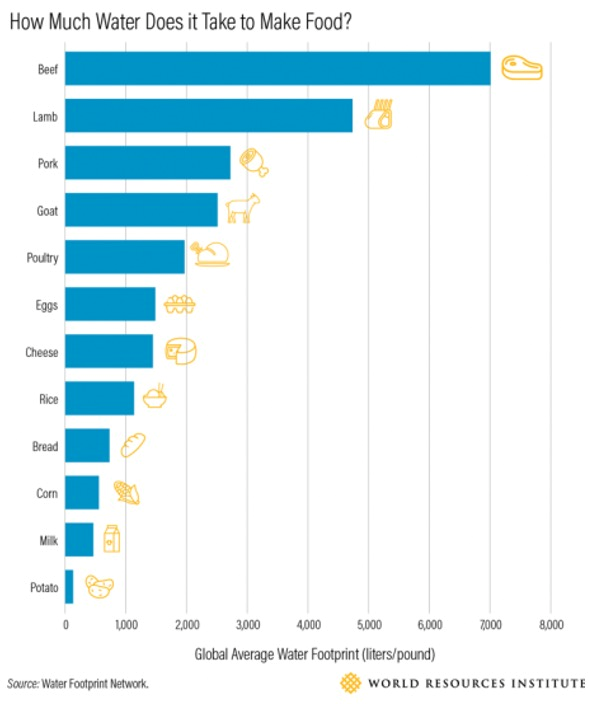
Every day, each of us generally consumes about 100 gallons of water for our basic needs of drinking, bathing, cooking, toiletries, etc. (USGS, 2019; Kobir, 2024; and Philadelphia City Government, 2024). The United States Geological Survey (USGS) estimates that the average American needs 80-100 gallons per day for basic use and consumption (indoor use). The Arizona Department of Water Resources (ADWR) estimates that Arizonans consume an average of 146 gallons of water per day (ADWR, 2024).
As discussed in a recent article in this newsletter (Silvertooth, 2024) the water required to produce the food supporting an average Arizonan can range from 800 to 1,500 gallons per day. Thus, we can use an estimate of 1,000 gallons consumed per day to support our individual food requirements (Anyabwile and Walker, 2019; Wheeler, 2022; Food Print, 2024; Michel, 2023; Smith, 2012).
If this estimate of “virtual water” use is expanded to include clothing, appliances, vehicles, and other items in our common daily use the average water footprint for Americans easily comes up to 2,000 gallons of water per day (ASPE, 2022).
Looking at this more closely, we can see quite a wide range of water requirements to produce some common food items (Figure 1). It is interesting to note the increasing water requirements associated with meat products and that beef is commonly found at the top of the list.

Figure 1. Water requirements to produce some common food
items. Source: World resources institute, Anyabwile and Walker, 2019.
Considering daily indoor use and diet, a person can develop estimates on their own personal daily water consumption and water footprint by use of one of the water footprint calculators available on-line (i.e., Water Footprint Calculator).
Some good examples of water requirements (footprint) for basic food and daily use products include the following (Wade, 2024):
The important point to consider is that we all use more water every day than is commonly realized. Water is essential to support all life and it takes a lot of water to grow plants and support animals that everyone needs to live and survive.
There is a strong demand for the food products shown in Figure 1 and all other food products as well. As consumers, we are all the direct beneficiaries of the water used to produce the crops with all the fruits and vegetables that come from them. Healthy animals require good food, which all comes from plants, i.e., alfalfa. Everything we consume has a significant water footprint.
We commonly devour our way through tons of good food while being totally oblivious to the reality of what it takes to put it all in the markets and ultimately on our kitchen tables. It is good for us to recognize the realities of the water requirements that support the production and provision of our food, particularly in these times of water shortages.
References:
Anyabwile, A. and S. Walker. 2019. 5 Ways to put food on a water diet. World Resources Institute. https://www.wri.org/insights/5-ways-put-food-water-diet
Arizona Department of Water Resources. 2019. Water Your Facts. Arizona Water Facts. https://www.arizonawaterfacts.com/water-your-facts
Arizona Department of Water Resources (ADWR). 2024. Conservation. https://www.azwater.gov/conservation/public-resources
ASPE. 2022. New research shows most Americans are unaware of their daily water consumption. ASPE Pipeline. https://aspe.org/pipeline/new-research-shows-most-americans-are-unaware-of-their-daily-water-consumption/#:~:text=Most%20believe%20they%20use%20less%20than%20100%20gallons,indirectly%20%28e.g.%2C%20the%20water%20required%20to%20produce%20food%29.
Food Print. 2024. The Water Footprint of Food. https://foodprint.org/issues/the-water-footprint-of-food/
Kobir. 2024. How many gallons of fresh water do we use per day. https://medium.com/rocklinca/how-many-gallons-of-freshwater-do-we-use-per-day-7987edf6b1bb
Michel, D. 2023. Water and Food: How, When, and Why Water Imperils Global Food Security. Center for Strategic and International Studies. https://www.csis.org/analysis/water-and-food-how-when-and-why-water-imperils-global-food-security
Philadelphia City Government. 2024. Gallons Used Per Person Per Day. https://water.phila.gov/pool/files/home-water-use-ig5.pdf
Smith, T. 2012. World Water Day: How much water do you use in a day? Climate Home News. https://www.climatechangenews.com/2012/03/22/world-water-day-how-much-water-do-you-use-in-a-day/
United States Geological Survey. 2019. How much water do I use at home each day? https://www.usgs.gov/special-topics/water-science-school/science/water-qa-how-much-water-do-i-use-home-each-day
Wade, M. 2024. Where does our water wind up? Ag Alert, California Farm Bureau Federation. 7 February 2024.
Water Footprint Calculator. 2024. https://watercalculator.org/water-footprint-of-food-guide/
Wheeler, M. 2022. Did You Know’ Series: How Much Water Are We Actually Using? Virginia Water Resources Research Center, Virginia Tech University. https://www.vwrrc.vt.edu/2022/03/31/did-you-know-series-how-much-water-are-we-actually-using/
I hope you are frolicking in the fields of wildflowers picking the prettiest bugs.
I was scheduled to interview for plant pathologist position at Yuma on October 18, 2019. Few weeks before that date, I emailed Dr. Palumbo asking about the agriculture system in Yuma and what will be expected of me. He sent me every information that one can think of, which at the time I thought oh how nice!
When I started the position here and saw how much he does and how much busy he stays, I was eternally grateful of the time he took to provide me all the information, especially to someone he did not know at all.
Fast forward to first month at my job someone told me that the community wants me to be the Palumbo of Plant Pathology and I remember thinking what a big thing to ask..
He was my next-door mentor, and I would stop by with questions all the time especially after passing of my predecessor Dr. Matheron. Dr. Palumbo was always there to answer any question, gave me that little boost I needed, a little courage to write that email I needed to write, a rigid answer to stand my ground if needed. And not to mention the plant diagnosis. When the submitted samples did not look like a pathogen, taking samples to his office where he would look for insects with his little handheld lenses was one of my favorite times.
I also got to work with him in couple of projects, and he would tell me “call me John”. Uhh no, that was never going to happen.. until my last interaction with him, I would fluster when I talked to him, I would get nervous to have one of my idols listening to ME? Most times, I would forget what I was going to ask but at the same time be incredibly flabbergasted by the fact that I get to work next to this legend of a man, and get his opinions about pest management. Though I really did not like giving talks after him, as honestly, I would have nothing to offer after he has talked. Every time he waved at me in a meeting, I would blush and keep smiling for minutes, and I always knew I will forever be a fangirl..
Until we meet again.
Time flies. February is right around the corner and that means it is farm equipment/ag trade show season. Upcoming regional events include the World Ag Expo, Tulare, CA, February 13-15, the Southwest Ag Summit, Yuma, AZ, February 20-22, and AgroBaja, Mexicali, Mexico, March 7-10. If you are interested in the latest ag tech and farm machinery, all are outstanding events and well worth attending. For more information, click on the links below.

Fig. 1. Upcoming farm equipment/ag trade show events: World Ag Expo, Tulare,
CA, February 13-15, 2024 theSouthwest Ag Summit, Yuma, AZ, February 20-
22,2024 and AgroBaja, Mexicali, Mexico, March 7-10, 2024.